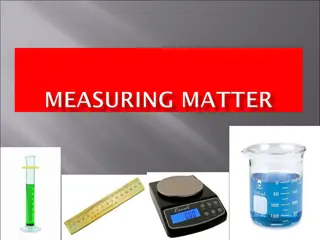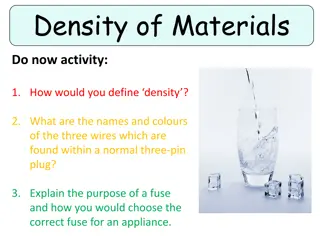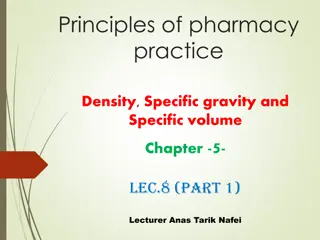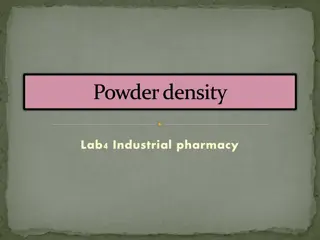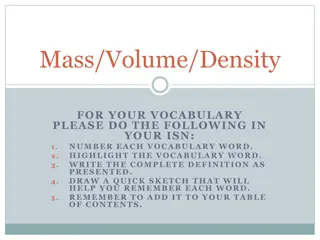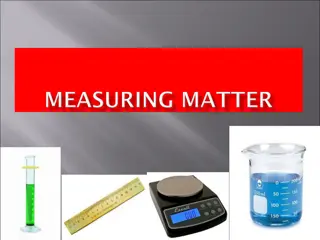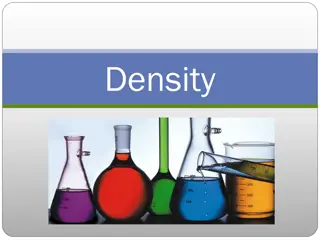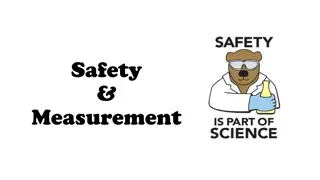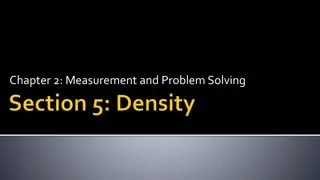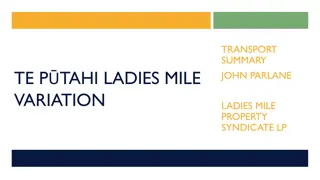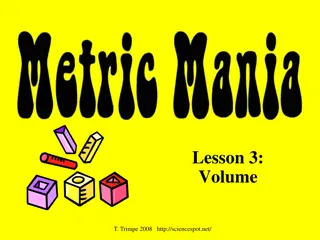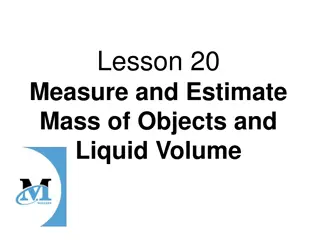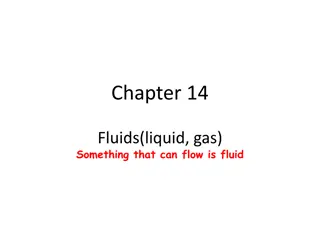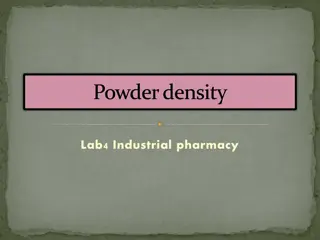Understanding Measurement: Mass, Volume, Density
Explore the world of measurement with a focus on mass, volume, and density. Learn about the International System of Units (SI), prefixes used in measurement, base units for different quantities, measuring length and volume, and reading the meniscus in a graduated cylinder. Enhance your knowledge of essential concepts in science and everyday life.
Download Presentation

Please find below an Image/Link to download the presentation.
The content on the website is provided AS IS for your information and personal use only. It may not be sold, licensed, or shared on other websites without obtaining consent from the author. Download presentation by click this link. If you encounter any issues during the download, it is possible that the publisher has removed the file from their server.
E N D
Presentation Transcript
Measurement Most nations use a system of measurement based on multiples of ten. Known as the International System of Units, this system is often abbreviated SI. All SI standards are universally accepted and understood by scientists. The SI system is easy to use because its based on powers of ten. Prefixes; deci- , centi-, ect. are used with the names of the base units to indicate what power of ten should be used with the base unit. 2
Prefix Symbol Multiplying Factor 1000.0 100.0 10.0 1.0 Kilo- Hecto- Deka- Basic Unit k h D Meter, Liter, Gram d c m Deci- Centi- Milli- 0.1 0.01 0.001 3
Measurement Every type of quantity measured in SI has a base unit and a symbol for that unit. These names and symbols are shown in the table below. Quantity Measured Unit Length Meter m Mass Kilogram kg Volume Cubic Meter (solid) m3 Symbol Liter (liquid) L Time Second s Temperature Kelvin K 4
Length Length is the distance between two points. The SI base unit of length is the meter (m). Metric rulers and meter sticks are used to measure length. Always measure centimeters to the nearest tenth (0.1 cm). What does not to scale mean? 5
Volume The amount of space occupied by an object is called its volume. If you want to measure the volume of a regularly shaped object, such as a brick, you measure its length, width and height and multiply the three numbers together. Vol. = L(cm) x W(cm) x H(cm) - the units would be cm3 6
Volume To measure the volume of a liquid, you would use a graduated cylinder. When liquid is placed into a container, it forms a meniscus (a curved surface that is lower in middle than at the edges). 7
Volume To read the meniscus, you have to place it on a stable desk top. (NEVER read a graduated while holding it in your hand.) Read the meniscus at eye level. 8
Volume To measure the volume of an irregular solid we use a technique called water displacement. An example of an irregular solid is a paperclip. Archimedes Volume = ending volume(mL) - starting volume(mL) * Make sure the starting volume covers the object completely.* *Remember to record both the starting and ending volume.* 9
Mass Mass is a measurement of the amount of matter in an object. The SI unit for mass is the kilogram (kg). For measuring objects of small mass, grams (g) are used. Mass in the laboratory will be measuring with a triple-beam balance in grams (g). *Remember mass and weight are different. Weight is the measure of the force of gravity on an object. Weight is measured in Newton's (N).* Mass is a constant, it does not change. Weight can vary, it changes with location. Tutorial http://www.ohaus.com/products/education/weblab/TBBentry.html 10
Example 1 Hundreds = ________ Tens = ________ Ones = ________ Tenths = ________ TOTAL = ________ grams 11
Example 2 Hundreds = ________ Tens = ________ Ones = ________ Tenths = ________ TOTAL = ________ grams 12
Example 3 Hundreds = ________ Tens = ________ Ones = ________ Tenths = ________ TOTAL = ________ grams 13
Density The mass and volume of an object can be used to find the density of the material. Density is the mass per unit volume of a material. D= m/v Density is a derived unit. You can find it by dividing the mass (g) by its volume (mL or cm3). The units for density are either g/mL or g/cm3. 14
Density Example: The mass of an object is 10.0g and the volume is 2.0cm3. What is the density of this object? SOLVE 1. Density = mass/volume 2. Density = 10.0g/2.0cm3 3. Density = 5.0 g/cm3 15
Density exercise #1: 1. Write formula 2.Sub in the # & units 3.Calculate answer include units Chris determines that a piece of an unknown material has a mass of 4.9 g and a volume of 6.6 cm3. What is the density of the material, rounded to the nearest tenth. 16
Density exercise #2: 1. Write formula 2.Sub in the # & units 3.Calculate answer include units Kristen finds a rock on the way to school. In the laboratory she determines that the volume of the rock is 22.9 cm3, and the mass in 40.2 g. What is the density of the rock, rounded to the nearest tenth? 17
Density The density of water is 1.0g/cm3. If an object has a density greater than 1.0g/cm3 it will sink in water. If an object has a density less than 1.0g/cm3 it will float. ___ has a density of 7.9g/cm3, will it sink or float? ________ ___ has a density of 0.24g/cm3 will it sink or float? _______ What is the density of cork if we cut it in half? __________ **It doesn t matter how many pieces we cut an object into, the density of an object NEVER changes.** 18 Density Practice http://www.edinformatics.com/math_science/mass_volume_density.htm
Density exercise #3: 1. Write formula 2.Sub in the # & units 3.Calculate answer include units A chemist wants to know if a certain liquid is denser than water. They need to know if it will sink rather than float. They know the density of liquid water to be 1g/ml. The liquid has a calculated mass of 15 grams. Using a graduated cylinder they find the volume to be 7.5 milliliters. Will the liquid sink or float in water? 19
Density exercise #4: 1. Write formula 2.Sub in the # & units 3.Calculate answer include units An engineer working in the automotive industry needs to test the viscosity of a new oil for engine lubrication. They find the mass of a 10ml sample to be 8.5 grams. What is the density of this oil? And, will it sink or float in water? 20


